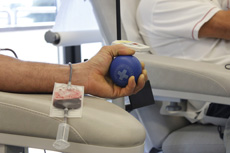World Blood Donor Day on 14 June – high blood safety standards in Germany
Blood products in Germany are safe – this is assured thanks to a diverse monitoring system. The Paul-Ehrlich-Institut (PEI), Federal Institute for Vaccines and Biomedicines constantly monitors the safety of blood products and instructs that additional test methods should be implemented if required. A recent example is the introduction of tests for all red blood cell concentrates and platelet concentrates for Hepatitis E virus.

Since the increased occurrence of transfusion-related infections with HIV (human immunodeficiency virus) in the 1980s, but also hepatitis viruses (hepatitis B and C viruses), the PEI has introduced a number of measures aimed at minimising the risk of infection: On the one hand, potential donors with an increased transmission risk shall be deferred or excluded from donating blood; on the other hand, the PEI established screening methods which complement each other, i.e. serological and molecular biology test methods.
Current haemovigilance report confirms the safety of blood products in Germany
The complex package of measures established by the PEI is successful: With the aid of an established reporting system for products for which the PEI is responsible, serious incidents in the manufacture of blood components and serious adverse reactions in the donor or the blood recipient are systematically recorded and assessed. The PEI publishes these data at regular intervals and evaluates the risk of transmission for transfusion-related infection. As the PEI was able to show in its current haemovigilance report the transmission risk for the three classical pathogens, HIV, hepatitis B and hepatitis C virus, could be reduced below one case per two mission administrated blood components.
New compulsory test methods have been established as binding as part of a so-called graduated plan procedure . The reason for the recently completed graduated plan procedure for testing for hepatitis E virus (HEV) by means of the so-called nucleic acid amplification technique (NAT) was the increase in HEV infections reported to the Robert-Koch-Institut, which is responsible for epidemiology in Germany. Many other European countries, too, registered an increase in HEV infections in the past few years. As part of a simulation study, researchers of the PEI examined which number of transfusion-related HEV infections can be expected if various test strategies were introduced in Germany (cf. Kamp C et al. 2018). The results made an important contribution to the establishment of the new test method.
Analysis of supply and demand for blood products
Besides, the PEI records the manufacture and the consumption of blood products in Germany anually to make supply and demand transparent and to identify trends on the supply situation as early as possible. These data are published annually.
As shown in the annual reports, the consumption of blood products has decreased. Among other things, this has happened thanks to the "Patient Blood Management", which has meanwhile been established worldwide. This conception has been a permanent component of the WHO agenda for the improvement of transfusion safety. It improved patient safety by diagnosing anaemia in time before postponable operations with a high transfusion risk. Furthermore, measures designed to save allogeneic blood are taken to an increasing extent to keep the loss of blood to a minimum Thus, the treatment concepts altogether assure a mindful use of blood reserves.
The reports also show a decrease in blood donations since 2011. In 2018, around one million fewer donations were provided than only seven years ago. The overall number of blood donations (wholeblood, apharesis, and autologous blood donations) has thus decreased from around 7.6 million donations to around 6.5 million donations.
Publication
Kamp C, Blümel J, Baylis SA, Bekeredjian-Ding I, Chudy M, Heiden M, Henseler O, Keller-Stanislawski B, de Vos AS, Funk MB (2018): Impact of hepatitis E virus testing on the safety of blood components in Germany - results of a simulation study.
Vox Sang 113: 811-813.
Online-Abstract
Contact:
Paul-Ehrlich-Institut
Press Office
Telefon: +49 6103 77 1030
Email: presse@pei.de
top



